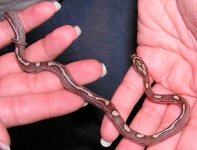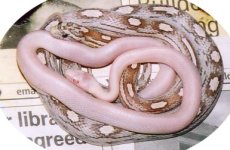Part of the problem with the whole question about motley vs. motley/stripe vs. striped animals is that there are some motlies out there that are misrepresented as motley stripes, and some stripes which are actually motley striped animals. Confused????
Well, in order for an animal to truly be a stripe, it has to have the stripes arranged in such a way as to have the uppermost center portion of ground pattern being wider than the other ground patterns between the dorsal stripes. Here is an example posted originally by Walter Smith of his lavender striped baby:
However, the motley/stripe animal can look very much like a full stripe. The key is that the center ground color portion is far more narrow. Here is a picture origianlly posted by Ken (Kenster) of his snow motley/stripe:
You can see the difference between these two patterns, when they are side by side, but many people miss the distinction if they have only one animal.
So, a person actually has a motley/stripe, but breeds it to a stripe. The babies will either be stripes or stripe/motlies. However, again because of the lack of understanding about what makes a stripe unique from a motley/stripe, the confusion continues and no one knows for sure what is what. The same thing can happen if the original snake is bred to a motley. The resulting hatchling will come out as motlies and motley/stripes. Where did the motlies come from? Well, it's easy to see once you know what you have.
Motley and Stripe are both genes found on the DNA strand at the same locus (location). Each locus has two alleles (genes) which can be the same (homozygous) or different (heterozygous). Since the motley and stripe genes are found on the same locus, there are some unique aspects about how these genes work. An animal that is het for motley has one normal gene and one motley gene at the prescribed locus. An animal that is motley has two motley genes there. An animal that is het for stripe has one normal gene and one stripe gene, and a striped animal has two stripe genes. A motley/stripe has one motley gene and one stripe gene at that same locus. So, a motley/stripe is an animal that is double het for motley and stripe. However, since they are located on the same allele, the pattern mutations show through because there is no normal gene present. Further, the motley and stripe gene appear to be co-dominant to one another. This means that an animal with both genes will show some effect from both pattern mutations to one degree or another. It may only that narrowing of the center ground color strip, but it is an effect nonetheless.
I'm sure that's all as clear as mud, but that's the way I understand it. Hope it helps some!



